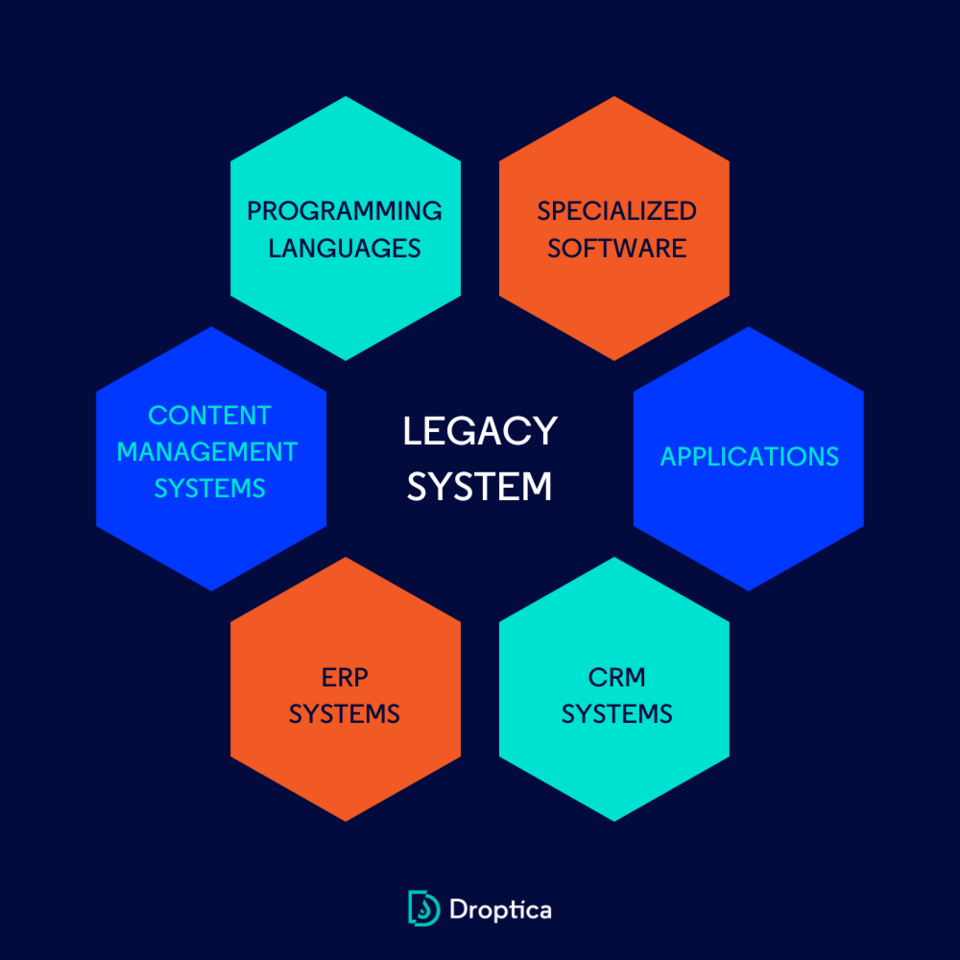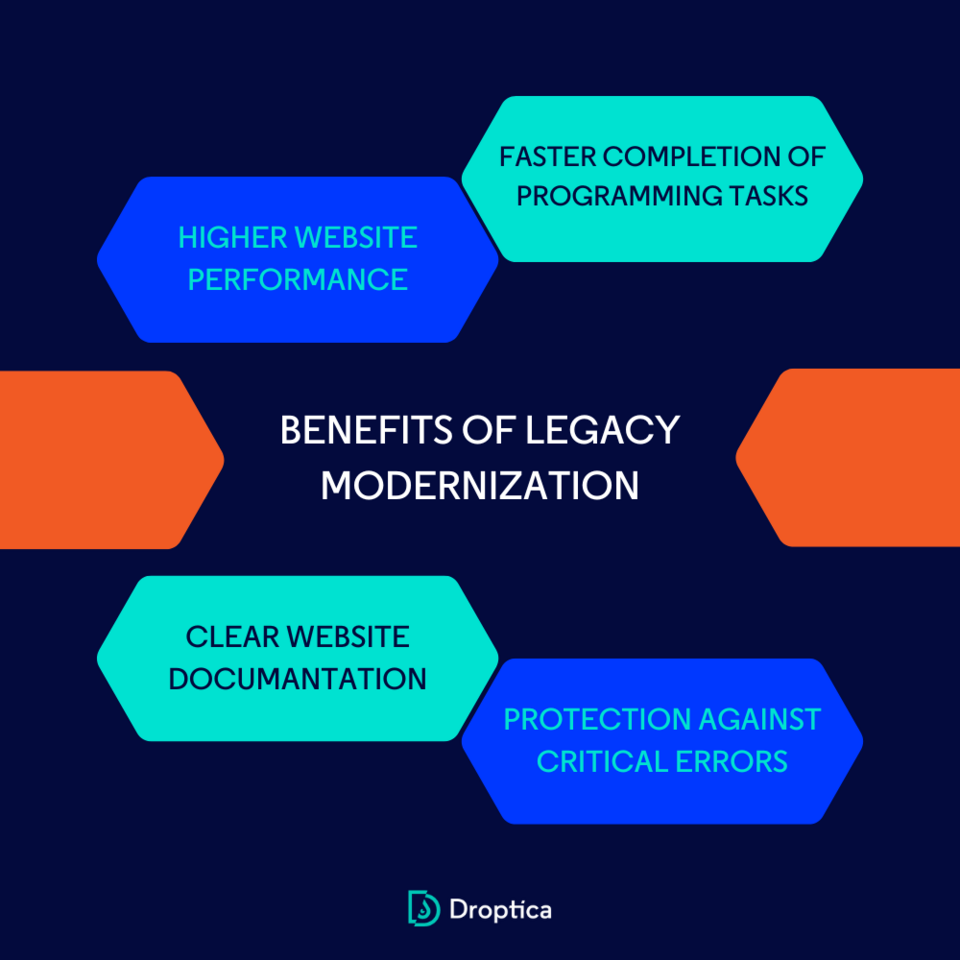
Legacy System - What is it And Why Should You Take Care of it?
Are you familiar with the term "legacy system"? You may be using one without even realizing it. Few people know that this type of software can put their business at risk. These outdated technological systems can cause your business to fall behind, exposing you to security breaches and increased costs. In this article, we'll discuss what a legacy system is, the risks it poses, and why you should modernize it.
What is a legacy system?
A “legacy system” is a term used to describe IT systems that an organization continues to operate in its work, even though they are, for example, outdated or incompatible with current coding standards. These are often systems based on no longer supported or developed technologies, a phenomenon known as “technology debt.”
An example is if your company uses version 6 (or soon also version 7) of Drupal, while the latest supported version is Drupal 10. This difference in versions means that your system isn’t up to date with the latest updates and improvements. This can lead to several problems related to, among other things, having identified and unpatched security holes that can cause potential errors resulting in compromised data integrity, confidentiality, and availability. As a result, this exposes the organization to costs and reputational damage.
What are legacy systems examples?
Examples of legacy systems vary and depend on the company's specific business. Often this category includes older versions of content management systems, such as the aforementioned Drupal, as well as Joomla and WordPress, where newer versions are available but not implemented by the organization.

It’s also true for ERP or CRM systems that have been customized to meet a company's specific needs but have become obsolete over time. Also, specialized software used in various industries, such as CAD systems for engineers, can become legacy if not regularly updated.
The situation is similar for applications or even the operating system on your computer that you deal with as an individual. This kind of software can also be a legacy system if you don't perform ongoing updates.
Programming languages can also be viewed as legacy. For example, COBOL is a language still used in some banking and government systems. Maintaining these applications is crucial to the business, and the cost of doing so is increasing due mainly to a shortage of qualified specialists.
How to recognize a legacy system?
Recognizing whether you’re working with a legacy system is not difficult at all. A programmer may notice specific indications in the code. Such signals may include complicated, incomprehensible code that is no longer maintained or developed, a lack of website documentation, or simply using old programming languages.
You can also verify for yourself whether you’re dealing with a legacy system. All you need to do is determine what version of the software you have. For example, if you're using a Drupal content management system, you can visit Drupal's status page in your admin panel to see if your version is the latest. Similarly, checking the version of the framework, database, or PHP version you’re using can help you assess whether you’re up to date with technology updates.
What are the risks of a legacy system?
Although they may appear reliable and well-tested, legacy systems often involve serious risks we don't see at first glance. These systems created years ago, for example, are no longer compatible with current technology standards today, leaving them vulnerable to many problems. Stagnant software means lower business performance but also direct threats to its security. What exactly does your company risk if it uses such systems?
No technological support for the legacy system
Legacy systems are often no longer supported by their developers. It means that in case of problems, bugs, or security vulnerabilities, it may not be easy to get the necessary fixes or assistance. Taking over software support generates additional costs and requires time and specialists with the right skills.
Difficulties in developing the system
When a company wants to implement new features or enhancements to, for example, a website, it can be difficult or impossible due to outdated technologies. Old versions of programming languages or database management systems may not be compatible with new tools for developers or the solutions they use.
Cost and time evaluation problems
Due to the often complex and incomprehensible nature of obsolete code, it’s difficult to estimate how much time and resources will be required to modify or fix it. The situation applies to the work of the organization's in-house development team and the establishment of a potential partnership with, for example, an external software development company.
Potential security issues
Lack of support for older systems often includes no security updates. It can lead to the system's exposure to hacking attacks and data leaks, resulting in financial and reputational losses.
Occurrence of repetitive errors
Legacy systems often generate issues that are difficult to resolve due to outdated code or its intricacy, and such problems tend to recur. If the same bug reoccurs several times, even after it has been theoretically patched, it can signal that the system is legacy and needs to be upgraded rather than just a temporary attempt to resolve a particular bug.
Why do you need a legacy modernization?
Although moving from a legacy system may seem complicated and costly, it's worth considering such an upgrade rather than struggling to maintain and trying to develop an outdated system through which your business could lose much more than just time and money. Changing to modern technology and systems can bring many benefits to your business. Learn about some of them.

Higher website performance
Upgrading your legacy system can significantly improve your website performance. By improving your web page loading speed, its rankings in search results can improve, which will also translate into more comprehensive visibility to potential customers.
Shorter time to complete programming tasks
Code refactoring, i.e. turning chaotic, non-compliant code into clean code, is a one-time expense that can pay itself quickly. Improving the code and bringing it up to good programming standards as part of a legacy system upgrade will make future tasks faster and more efficient, such as adding new features or fixing bugs.
Clear documentation and understanding of the code
Modernizing outdated code goes hand in hand with creating documentation that explains exactly what is happening in the system and why. Understanding the system allows you to better plan and manage your business model by more accurately estimating the task complexity, quickly deploying new employees, and being resilient to staff changes.
Protection against critical errors
Legacy systems are often prone to severe vulnerabilities that can affect critical aspects of your business, such as payments or user authorization. Upgrading your system can help secure your business from exploiting known vulnerabilities, which helps improve stability, system security, and website integrity.
Legacy system - summary
Continuing to work on a legacy system can pose numerous risks and put obstacles to your business growth. Despite the initial cost and level of the process complexity, upgrading such software can bring benefits in terms of improved security or streamlined business management. Remember that investing in a technology upgrade translates into long-term goals that justify the initial expense, as the potential gain is greater than the cost of maintaining an outdated system. Our development team will be happy to help you support your systems and upgrade them to the latest possible version, such as migrating websites to Drupal 10.













